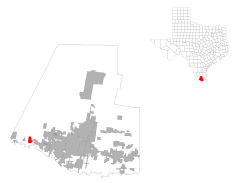La Joya, Texas
| La Joya, Texas | |
|---|---|
| City | |
| City of La Joya | |
 Location of La Joya, Texas |
|
 |
|
| Coordinates: 26°14′31″N 98°28′48″W / 26.24194°N 98.48000°WCoordinates: 26°14′31″N 98°28′48″W / 26.24194°N 98.48000°W | |
| Country | |
| State |
|
| County |
|
| Area | |
| • Total | 2.9 sq mi (7.5 km2) |
| • Land | 2.8 sq mi (7.2 km2) |
| • Water | 0.1 sq mi (0.3 km2) |
| Elevation | 174 ft (53 m) |
| Population (2010) | |
| • Total | 3,985 |
| • Density | 1,187.6/sq mi (458.5/km2) |
| Time zone | Central (CST) (UTC-6) |
| • Summer (DST) | CDT (UTC-5) |
| ZIP code | 78560 |
| Area code(s) | 956 |
| FIPS code | 48-40384 |
| GNIS feature ID | 1339334 |
La Joya is a city in western Hidalgo County, Texas, United States, along U.S. Route 83 between Mission and Rio Grande City. The population was 3,985 at the 2010 census. La Joya is part of the McAllen–Edinburg–Mission and Reynosa–McAllen metropolitan areas.
Its name, meaning "the jewel," was inspired by a small natural lake west of the city; early settlers were said to observe that the lake shined in the sun like a jewel. [1] The site on which La Joya was founded was part of what was known as Los Ejidos de Reynosa Viejo. The ejidos were the shared grazing lands used for the livestock of the settlers of Reynosa Viejo. During the early 1800s, at the site of what is now La Joya, Francisco de la Garza, a descendent of the early colonizers of the area, founded a community, called Tabasco, adjacent to the northern bank of the Rio Grande. It was a prosperous community that died out after floods in 1908 and 1909. The settlers moved their belongings just north to higher and less flood-prone ground, current day La Joya.[2]
La Joya is located at 26°14′31″N 98°28′48″W / 26.24194°N 98.48000°W (26.241996, -98.480138).
According to the United States Census Bureau, the city has a total area of 2.9 square miles (7.5 km2), of which 2.8 square miles (7.3 km2) is land and 0.1 square miles (0.26 km2) (3.47%) is water.
...
Wikipedia
